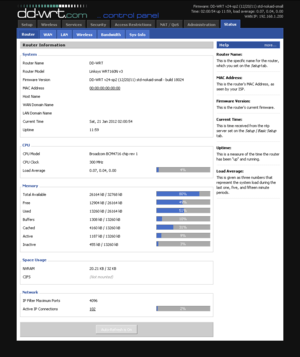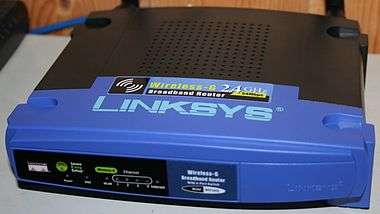DD-WRT
DD-WRT is Linux-based firmware for wireless routers and access points. Originally designed for the Linksys WRT54G series, it now runs on a wide variety of models. DD-WRT is one of a handful of third-party firmware projects designed to replace manufacturer's original firmware with custom firmware offering additional features or functionality.
 | |
 DD-WRT's Web interface | |
| Developer(s) | Sebastian Gottschall / NewMedia-NET |
|---|---|
| Initial release | 22 January 2005[1] |
| Stable release | v24 SP1 (Build 10020)
/ 27 July 2008 |
| Preview release | Constantly being updated in beta form in forums or at download1 |
| Repository | |
| Type | Router operating system |
| License | Various proprietary and free software |
| Website | www |

Sebastian Gottschall, a.k.a. "BrainSlayer", is the founder and primary maintainer of the DD-WRT project.[2] The letters "DD" in the project name are the German license-plate letters for vehicles from Dresden, where the development team lived.[3] The remainder of the name was taken from the Linksys WRT54G model router, a home router popular in 2002–2004. "WRT", also used by the OpenWrt router firmware project, comes from the generic abbreviation for "Wireless Receiver / Transmitter", which may have been the original Linksys meaning.
Buffalo Technology and other companies have shipped routers with factory-installed, customized versions of DD-WRT.[4][5] In January 2016, Linksys started to offer DD-WRT firmware for their routers.[6]
Features
Among the common features of DD-WRT are
- access control
- bandwidth monitoring
- quality of service
- WPA/WPA2 (personal and enterprise)
- iptables firewall
- Universal Plug and Play
- Wake-on-LAN
- Dynamic DNS
- AnchorFree VPN
- wireless access point configuration
- multiple SSIDs
- overclocking
- transmission power control
- Transmission BitTorrent client[7]
- Tor[8]
- router linking
- ssh
- telnet
- wireless distribution system
- RADIUS support
- XLink Kai networks
- OpenVPN
- WireGuard [9][10]
| Feature | Micro (2 MB)[lower-alpha 1] |
Mini (4 MB) |
Nokaid (4 MB) |
Standard (4 MB) |
VOIP (4 MB) |
VPN (4 MB)[lower-alpha 2] |
Mega[lower-alpha 3] (8 MB) |
|---|---|---|---|---|---|---|---|
| ChilliSpot | |||||||
| Web management over HTTPS | |||||||
| IPv6 | |||||||
| JFFS2[lower-alpha 2] | |||||||
| XLink Kai daemon | |||||||
| MMC & SD card support | |||||||
| NoCat | |||||||
| OpenVPN | |||||||
| PPTP client | |||||||
| radvd | |||||||
| RFlow (traffic information) | |||||||
| Samba/CIFS client | |||||||
| Milkfish SIP router | |||||||
| SNMP | |||||||
| Secure Shell daemon | |||||||
| Wiviz | |||||||
- "Micro" builds additionally require 128 kB of Common Firmware Environment storage
- Smaller VPN JFFS builds are available for 4 MB units.
- Only on DD-WRT v24
It is also possible to build a bespoke firmware package.[11][12]
Version history
| Version | Release date | Changes | Refs |
|---|---|---|---|
| 16 | 22 January 2005 | Initial release. Created as a branch of Sveasoft Alchemy, which, in turn, is based on the Linksys WRT54G firmware | [1] |
| 22 | 25 July 2005 | ? | [13] |
| 23 | 25 December 2005 | Replaced the Alchemy kernel with the OpenWrt kernel | [14] |
| 23 SP 1 | 16 May 2006 | In this service pack, much of the code was overhauled and rewritten during the development of this release; many new features were added. | |
| 23 SP 2 | 14 September 2006 | The interface was overhauled, and some new features were added. Some additional router models are supported. | |
| 24 | 18 May 2008 | Allows up to 16 virtual interfaces with different SSIDs and encryption protocols. It can run on some PowerPC, IXP425-based router boards, Atheros WiSOC, and X86-based systems. It can also run to some extent on routers with low flash memory (ex. WRT54Gv8 or WRT54GSv7) | |
| 24 SP 1 | 26 July 2008 | Critical DNS security fix for an issue in dnsmasq, site survey security fixes, longer passwords, and flexible OpenVPN configurations. It can also run on additional hardware, including WRT300 v1.1, WRT310N, WRT600N, Tonze AP42X Pronghorn SBC, Ubiquiti LSX and Netgear, Belkin, and USR devices. | |
| In beta | Varies | Since 2010, the DD-WRT developers have frequently published beta builds for various routers. In January 2018 WireGuard was made available for routers with 8 MB or more flash and has been updated regularly by BrainSlayer | [15] |
Router hardware supported
DD-WRT supports many different router models, both new and obsolete. The project maintains a full list of currently supported models[16] and known incompatible devices.[17]
See also
References
- "Alchemy branch v16 by BrainSlayer". FreeWRT.Narod.ru. 22 January 2005. Archived from the original on 14 May 2013. Retrieved 29 July 2012.
- "About DD-WRT". dd-wrt.com. Archived from the original on 5 June 2020. Retrieved 4 July 2020.
- "What is DD-WRT?". DD-WRT Wiki. Retrieved 4 June 2020.
- "Buffalo Partners with NewMedia-NET" (Press release). 23 October 2007. Archived from the original on 16 January 2008. Retrieved 14 November 2007.
- Gottschall, Sebastian "BrainSlayer" (29 October 2007). "Congratulations on the partnership w/Buffalo!". Archived from the original on 14 January 2009. Retrieved 14 November 2007.
- Vaughan-Nichols, Steven J. (5 January 2016). "DD-WRT Linux firmware comes to Linksys routers". ZDNet. Archived from the original on 17 March 2019. Retrieved 5 July 2020.
- "dd-wrt/tree/master/src/router/transmission". GitHub. Archived from the original on 5 July 2020. Retrieved 5 July 2020.
- "dd-wrt/tree/master/src/router/tor". GitHub. Archived from the original on 5 July 2020. Retrieved 5 July 2020.
- "DD-WRT Products, Pros & Cons". Tenwitch. Archived from the original on 1 April 2018. Retrieved 19 February 2017.
- "All-in-One Guide to Choose and Set Up VPN On a DD-WRT Router". Best-VPN.net. 12 January 2017. Archived from the original on 5 July 2020. Retrieved 5 July 2020.
- "Firmware Modification Kit Documentation". bitsum.com. Archived from the original on 9 June 2020. Retrieved 5 July 2020.Firmware Modification Kit gives the user the ability to make changes to a firmware image without recompiling the firmware sources.
- "Best DD WRT Router 2018 - Buyer's Guide and Reviews". Heatonc. Archived from the original on 11 August 2017. Retrieved 19 December 2017.
- "Index of /stable/dd-wrt.v22/". dd-wrt.com. 25 July 2005. Retrieved 29 July 2012.
- "Index of /stable/dd-wrt.v23/". dd-wrt.com. 25 December 2005. Retrieved 29 July 2012.
- "ftp.dd-wrt.com/betas/". dd-wrt.com. Retrieved 6 January 2018.
- "Supported Devices". DD-WRT Wiki. Archived from the original on 4 June 2018. Retrieved 25 January 2018.
- "Known incompatible devices". DD-WRT Wiki. Archived from the original on 18 August 2018. Retrieved 25 January 2018.
External links
| Wikibooks has more on the topic of: DD-WRT |
| Wikimedia Commons has media related to DD-WRT. |